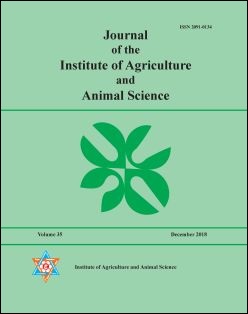Effect of Crop Establishment Methods on Performance of Rice in Rupandehi, Nepal
DOI:
https://doi.org/10.3126/jiaas.v36i1.48391Keywords:
benefit-cost ratio, direct seeded rice, transplanting method, system of rice intensification, yieldAbstract
An on-station experiment was conducted to assess the growth, productivity and profitability of rice under various crop establishment methods at the agronomy farm of Paklihawa Campus, Rupandehi, Nepal in 2019. The experiment was laid out in Randomized Complete Block Design with five treatments and four replications. The treatments included: Traditional Transplanting–Random (TTR), Traditional Transplanting–Line (TTL), System of Rice Intensification (SRI), Wet Direct Seeded Rice-Line (WDSRL) and Wet Direct Seeded Rice-Broadcasting (WDSRB). The results showed that plant height, number of tillers at 40 DAT, number of grains per panicle, 1000 grain weight, grain yield, straw yield and grain sterility percentage were significantly influenced by crop establishment methods, whereas number of tillers at 60 DAP, number of effective tillers at harvest, panicle length and harvest index were not significantly different among the treatments. TTR method produced the highest grain yield (4.58 t/ha), straw yield (7.25 t/ha) and benefit-cost ratio (3.28) followed by TTL. Hence, traditional transplanting method of rice establishment was found better than WDSR and SRI in terms of productivity and profitability. Direct seeding and SRI could also be an attractive alternative to transplanting because of lower labor requirement and cost of production

